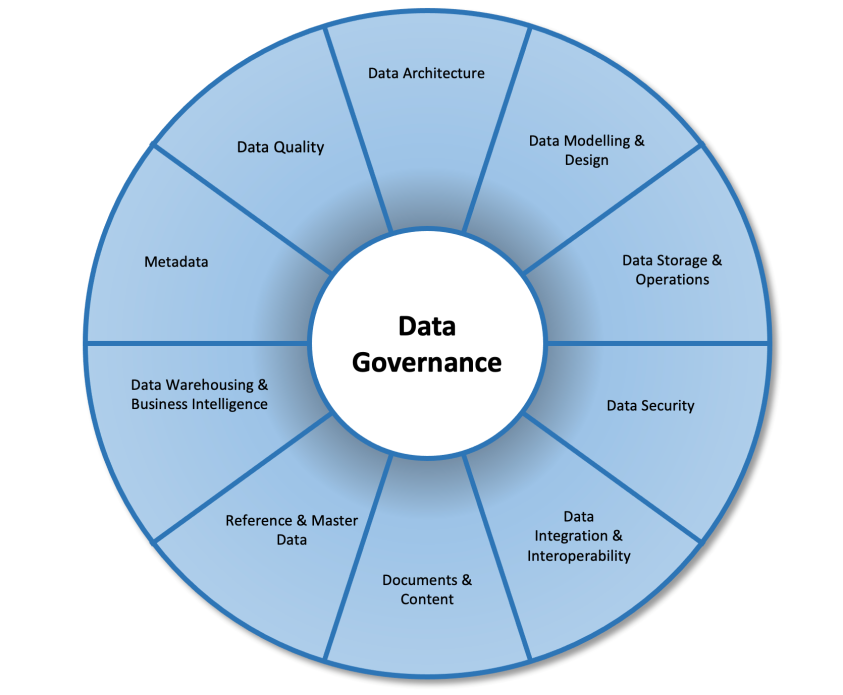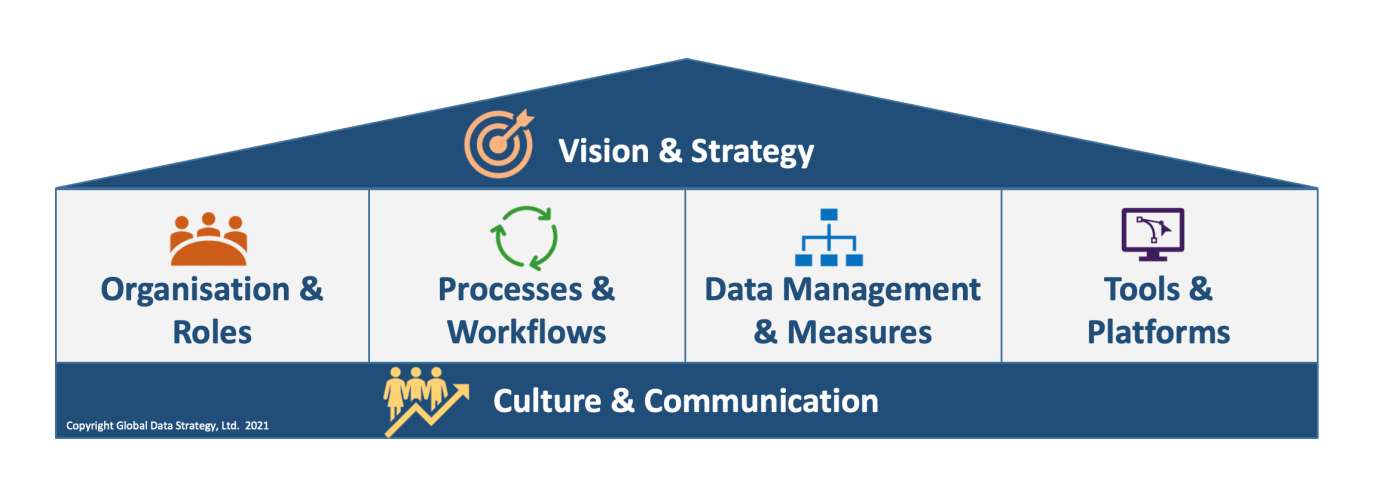
November 2022
Upcoming events by this speaker:
November 28 – 29, 2022:
Data Governance: A practical Guide
Data Governance: The Data Discipline at the hub of Data Management
The widely respected Data Management Association’s Data Management Book of Knowledge (DMBoK)[1] identifies 11 main disciplines of data management, including Data Architecture, Business Intelligence and so on. DMBoK portrays the 11 disciplines as a wheel, with 10 of the disciplines forming the spokes, and one at its centre. At this hub is Data Governance.
[1] Data Management Book of Knowledge, Second Edition, 2017, DAMA International

Figure 1: Data Management Association Data Management Wheel
Why does the DMBOK place Data Governance here? It contends that without Data Governance none of the other disciplines can ever function effectively, or fully deliver the benefits they promise. It sees it as the ‘must have’ capability for any organisation wanting to enhance the use and value of its data.
Why is Data Governance so critical? First it recognises that data is a critical business asset and so all data management activities should be led by the business. In too many organisations today data is still wrongly seen as something that IT does. Often IT valiantly tries to fulfil this role, but fails because it struggles to answer questions such as: what data is most important to the business, both today and to support our future business aspirations? Of the data related problems we face today which are the highest priority ones to tackle? IT of course has a key role to play in delivering the data improvements needed but cannot do so without being guided by business priorities and collaborating closely with the business to deliver them.
The primary purpose of Data Governance is to answer these questions by providing a framework of processes and accountabilities to steer and guide data improvement activities. By making the business primarily responsible for data improvement it acts as the bridge between the business and IT, crossing the chasm of misunderstanding which all too often separates business and technical data people.
How does Data Governance do this? It starts with a few central underlying principles. These are:
- Data is a business asset and should be managed actively like other business assets such as people, finance, products etc. Like any other asset data does not improve itself and will decline in value unless actively maintained and enhanced.
- The business must be responsible for leading efforts to improve the data asset and should set priorities on the basis of their impact & value to the business.
- Critical business data should be owned by accountable business people. In Data Governance these are usually called Data Owners, normally fairly senior business executives who carry out this role part time. There are several ways to allocate data ownership, but the important principle is that someone is ultimately responsible and so the buck stops with them.
- Day to day data maintenance and improvement of data should be led by designated subject matter experts who are authorised to act on behalf of the Data Owners. These are normally known as Data Stewards, though can sometimes be called Data Custodians, Data Governors and other role titles. These roles can be full or part time, depending on the breadth and depth of their responsibilities.
- As highlighted earlier, IT has an important supporting role to play in providing the technology and specialist data management expertise to support Data Governance and data improvement.
- Data Governance also recognises that all people within an organisation (and sometimes outside) who create, consume and modify data must be included in Data Governance activities. This implies the need for Data Governance to enhance data literacy and bring about culture change so that everyone is aware of, and actively participates in, improvement activities.
So how are these principles put into practice? The good news is that there are established frameworks and a body of best practices that can be referenced to help ensure that Data Governance can be implemented within any organisation. My own company, Global Data Strategy, has developed its own framework, which incorporates the best of other frameworks created elsewhere, plus our own extensive experience of helping to implement Data Governance in organisations across multiple industry sectors in many different parts of the world. The high level Global Data Strategy framework is shown in figure 1 below:

Figure 2: Data Governance Framework
Applying a simple framework such as this can accelerate and validate Data Governance implementation as:
- It identifies all the six activity areas that must be addressed to ensure successful Data Governance. Omitting any one of these will usually cause any specific organisational initiative to stutter or even collapse. For example, if you assign Data Owners and Data Stewards as part of an Organisation & Roles activity, but then do not develop the required Processes and Workflows they will need to carry out the role, they will inevitably fail.
- The Vision & Strategy activity area lays great emphasis on understanding the business drivers and priorities for better data, identifying the current priority data domains and problems that need to be addressed and forming a business case for action. This ensures that any Data Governance initiative directly aligns with and supports business priorities and needs, therefore maximising the chances of the business being willing to play the leading role.
- It can be used to assess the current readiness of any organisation to implement Data Governance by identifying what already exists, what can be adapted or what new elements and structures need to be put in place. For example, in many organisations people are already doing data ownership and data stewardship type roles but have never been formally recognised for their efforts.
- Applying a framework approach identifies the actions that are required to make Data Governance succeed and so helps to form a realistic roadmap. In particular, it’s vital to identify early tasks, both to start to build the foundations of Data Governance and to implement ‘quick wins’ in specific problem areas. These help to win support across the organisation and build momentum and deliver early benefits.
Alongside the new technology innovations and approaches such as Data Science, Analytics, Artificial Intelligence etc. Data Governance is today’s fastest growing data discipline. In a 2020 Dataversity survey [1] Data Governance was cited by 50% of survey respondents as their number one priority for 2022-23. They recognised that all the investments being made in the newer and more traditional disciplines of data management will not deliver their full potential unless a rigorous Data Governance framework is in place to make the data wheels spin. Without Data Governance the wheels can and will usually fall off. If you aspire to become a data driven organisation please make Data Governance your top priority too.